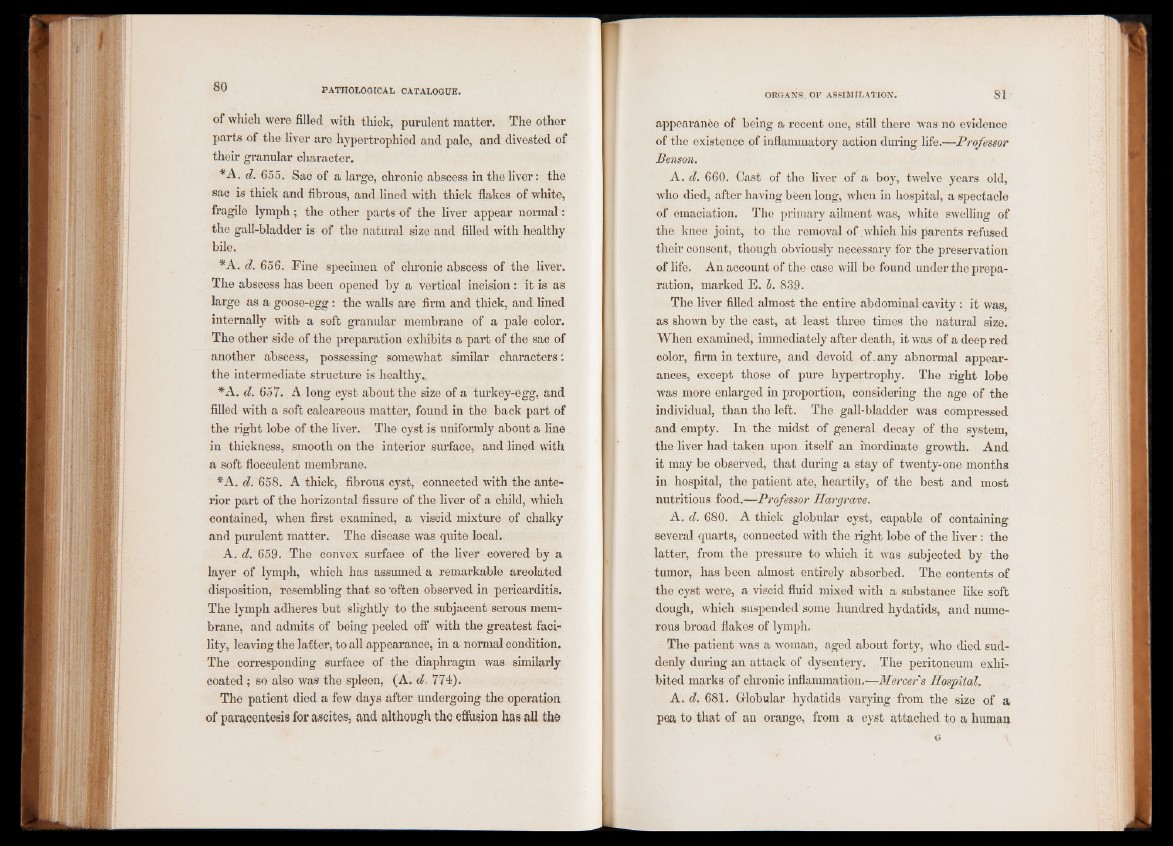
of which were filled with thick, purulent matter. The other
parts of the liver are hypertrophied and pale, and divested of
their granular character.
*A. d. 655. Sac of a large, chronic abscess in the liver: the
sac is thick and fibrous, and lined with thick flakes of white,
fragile lymph; the other parts of the liver appear normal:
the gall-bladder is of the natural size and filled with healthy
bile.
*A. d. 656. Fine specimen of chronic abscess of the liver.
The abscess has been opened by a vertical incision : it is as
large as a goose-egg: the walls are firm and thick, and lined
internally with a soft granular membrane of a pale color.
The other side of the preparation exhibits a part of the sac of
another abscess, possessing somewhat similar characters:
the intermediate structure is healthy.,
*A. d. 657.. A long cyst about the size of a turkey-egg, and
filled with a soft calcareous matter, found in the back part of
the right lobe of the liver. The cyst is uniformly about a line
in thickness, smooth on the interior surface, and lined with
a soft flocculent membrane.
*A. d. 658. A thick; fibrous cyst, connected with the anterior
part of the horizontal fissure of the liver of a child, which
contained, when first examined, a viscid mixture of chalky
and purulent matter. The disease was quite local.
A. d. 659. The convex surface of the liver covered by a
layer of lymph, which has assumed a remarkable areolated
disposition, resembling that so ’often observed in pericarditis.
The lymph adheres but slightly to the subjacent serous membrane,
and admits of being peeled off with the greatest facility,
leaving the latter, to all appearance, in a normal condition.
The corresponding surface of the diaphragm was similarly
coated; so also was the spleen, (A- d. 774).
The patient died a few days after undergoing the operation
of paracentesis for ascites, and although the effusion has all the
appearance of being a recent one, still there was no evidence
of the existence of inflammatory action during life.—Professor
Benson.
A. d. 660. Oast of the liver of a boy, twelve years old,
who died, after having been long, when in hospital, a spectacle
of emaciation. The primary ailment was, white swelling of
the knee joint, to the removal of which his parents refused
their consent, though obviously necessary for the preservation
of life. An account of the case will be found under the preparation,
marked E. b. 839.
The liver filled almost the entire abdominal cavity : it was,
as shown by the cast, at least three times the natural size.
When examined, immediately after death, it was of a deep red
color, firm in texture, and devoid of. any abnormal appearances,
except those of pure hypertrophy. The right lobe
was more enlarged in proportion, considering the age of the
individual, than the left. The gall-bladder was compressed
and empty. In the midst of general decay of the system,
the liver had taken upon itself an inordinate growth. And
it may be observed, that during a stay of twenty-one months
in hospital, the patient ate, heartily, of the best and most
nutritious food.—Professor Hargrave.
A. d. 680. A thick globular cyst, capable of containing
several quarts, connected with the right lobe of the liver: the
latter, from the pressure to which it was subjected by the
tumor, has been almost entirely absorbed. The contents of
the cyst were, a viscid fluid mixed with a substance like soft
dough, which suspended some hundred hydatids, and numerous
broad flakes of lymph.
The patient was a woman, aged about forty, who died suddenly
during an attack of dysentery. The peritoneum exhibited
marks of chronic inflammation.—Mercer's Hospital.
A. d. 681. Globular hydatids varying from the size of a
pea to that of an orange, from a cyst attached to a human
G